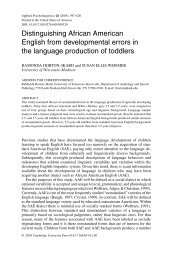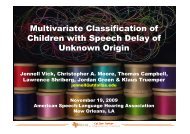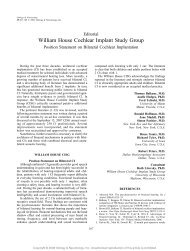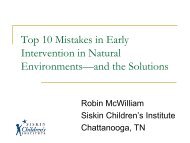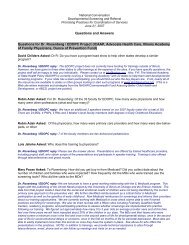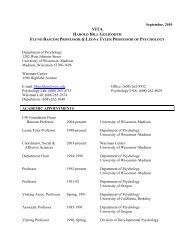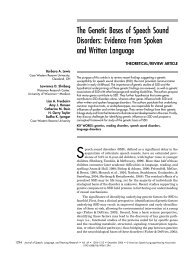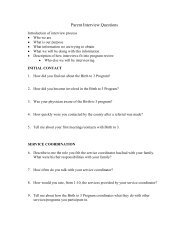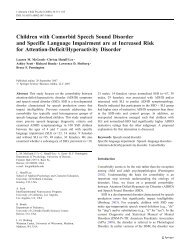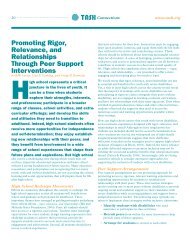Music and Language: A Developmental Comparison - Waisman ...
Music and Language: A Developmental Comparison - Waisman ...
Music and Language: A Developmental Comparison - Waisman ...
You also want an ePaper? Increase the reach of your titles
YUMPU automatically turns print PDFs into web optimized ePapers that Google loves.
298 Erin McMullen & Jenny R. Saffrantutions. In an exciting extension of this line of research, Patel, Gibson,Ratner, Besson, & Holcomb (1998) showed that a comparable P600 responseis elicited by unexpected musical events. In this study, subjects heardsix kinds of stimuli: sentences containing target words that were easy, difficult,or impossible to integrate meaningfully, <strong>and</strong> chord sequences containingtarget chords that were in the key, in a nearby key, <strong>and</strong> in a distantkey. P600 responses emerged for all four types of anomalies, with largerpeaks corresponding to more severe integration difficulty. Moreover, theresponses were quite similar for speech <strong>and</strong> music stimuli of comparabledifficulty. Others have found further similarities in early neural processingof linguistic <strong>and</strong> musical syntax, both of which make use of Broca’s area<strong>and</strong> its right-hemisphere homologue. In particular, syntactically incongruouswords <strong>and</strong> out-of-key chords tend to elicit an early negative component,stronger on the left in response to speech stimuli (ELAN: Hahne &Friederici, 1999) <strong>and</strong> on the right for musical stimuli (ERAN: Koelsch,Gunter, Friederici, & Schröger, 2000; Maess, Koelsch, Gunter, & Friederici,2001). Importantly, this response has been demonstrated in nonmusicians,indicating that explicit training is not necessary for this level of implicitknowledge to develop.Meaning in <strong>Language</strong> <strong>and</strong> <strong>Music</strong>Although lower-level parallels between music <strong>and</strong> spoken language arerelatively easy to discern, the relationship between the two at the level ofsemantics is less obvious <strong>and</strong> is likely where the systems diverge moststrongly. Certainly a sonata does not carry referential meaning in the sameway that a sonnet does. However, music can <strong>and</strong> does often elicit strong,predictable emotional responses from people who may vary by culture.The nature of these mappings from sound to response, <strong>and</strong> the means oftheir construction, is of interest to the cognitive scientist; thus a comparisonof the two “meaning-systems,” loosely defined, may be instructive.In the case of music, the “meaning” that adult listeners give to phrases ismost strongly related to the emotional responses they generate. We knowthat one of the basic building blocks for this is present from early infancy;several studies have found that infants as young as 2 months old, like adults,prefer consonance to dissonance (Trainor & Heinmiller, 1999; Trainor, Wu,Tsang, & Plantinga, 2002; Zentner & Kagan, 1998). This preference haslong been posited as an important underpinning of emotion in music (e.g.,Helmholtz, 1895). In addition, research has demonstrated infant preferencesfor higher-pitched music (Trainor & Zacharias, 1998), which oftencorrelates with positive emotional judgments (e.g., Juslin & Laukka, 2003).Furthermore, as with lullabies (Trehub, Unyk, & Trainor, 1993a, 1993b),



